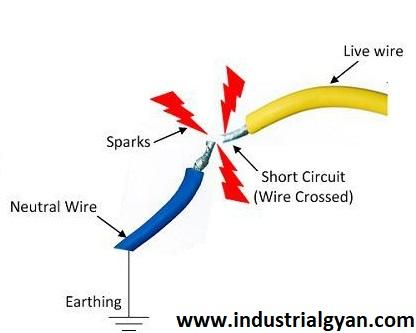Introduction
When it comes to electrical systems, it’s essential to understand the difference between short circuits and overloading. These two terms often cause confusion, but they refer to distinct issues that can occur in electrical circuits. In this article, we will explore the dissimilarities between short circuits and overloading, shedding light on their causes, effects, and potential solutions. So, let’s dive in and demystify the difference between short circuits and overloading.
Difference Between Short Circuit and Overloading
To grasp the dissimilarity between short circuits and overloading, we must first define each term individually and then examine its contrasting characteristics.
Short Circuit: An Unexpected Detour
A short circuit occurs when there is an unintended connection between two conductors in an electrical circuit. This connection bypasses the normal resistance, leading to a sudden surge in current flow. The most common cause of a short circuit is when a live wire comes into direct contact with a neutral wire or a ground wire. This contact creates a low-resistance pathway, causing a rapid increase in electrical current.

Effects of Short Circuit
- Electrical Sparks:- A short circuit often results in visible electrical sparks due to the intense flow of current and the sudden release of energy. These sparks can pose a fire hazard and cause damage to surrounding materials.
- Tripped Circuit Breakers or Blown Fuses:- The excessive current generated during a short circuit triggers the protective devices in the electrical system, such as circuit breakers or fuses. These devices detect the abnormal current and quickly interrupt the circuit, shutting off the power supply to prevent further damage.
- Overheating and Fire:- Due to the increased current flow, the electrical components involved in the short circuit can become overheated. This heat buildup can lead to melting insulation, damaged wires, and even electrical fires.
Overloading: When the Demand Exceeds the Limit
Overloading, on the other hand, occurs when the electrical circuit is burdened with more current than it can safely handle. It happens when the total power consumption of the connected devices exceeds the capacity of the circuit. Overloading can be caused by plugging in too many appliances, using high-power devices simultaneously, What is Skin Effect in Transmission Line: List of Factor affecting Advantages, or connecting equipment that draws excessive current to a circuit with a lower current rating.

Effects of Overloading
- Tripped Circuit Breakers:- When a circuit is overloaded, the excessive current triggers the circuit breaker, causing it to trip. This action is a protective measure to prevent overheating and potential fire hazards.
- Dimming Lights:- In cases of severe overloading, you may notice a dimming of lights or flickering in the electrical system. This occurs due to the insufficient supply of power to meet the demands of all the connected devices.
- Malfunctioning Appliances:- Overloading can strain appliances, leading to malfunctions, reduced efficiency, and even permanent damage. High power demand can cause motors to overheat, compressors to fail, and electronic components to degrade.
FAQs about Short Circuits and Overloading
To provide further clarity, here are some frequently asked questions about the difference between short circuits and overloading:
1. Can a short circuit cause overloading?
No, a short circuit does not cause overloading. Short circuits create a sudden surge of current by creating a low-resistance pathway, while overloading occurs when the current demand exceeds the circuit’s capacity.
2. How can I identify a short circuit or overloading issue?
A short circuit is often accompanied by visible sparks, tripped circuit breakers or blown fuses, and potential fire hazards. On the other hand, overloading can be recognized through dimming lights, tripped circuit breakers, and malfunctioning appliances.
3. What are the potential dangers of a short circuit?
Short circuits can lead to electrical fires, damage to electrical components, and pose risks to personal safety due to the release of sparks and excessive heat.
4. How can I prevent overloading in my electrical system?
To prevent overloading, distribute the power load evenly across different circuits, avoid connecting high-power devices to circuits with lower current ratings, and consider upgrading your electrical system if the demand consistently exceeds its capacity.
5. Is it safe to fix a short circuit or overloading issue myself?
It is strongly recommended to consult a qualified electrician to address short circuits or overloading problems. Dealing with electrical issues without proper expertise can be dangerous and increase the risk of accidents or further damage to the system.
6. Are short circuits and overloading common in residential settings?
Short circuits and overloading can occur in any electrical system, including residential settings. They can be caused by faulty wiring, improper installations, or a lack of awareness about electrical load management.
The Double Field Revolving Theory in Induction Motors: Unleashing Efficiency and Performance
Conclusion
Understanding the difference between short circuits and overloading is crucial for maintaining a safe and efficient electrical system. While short circuits involve unintended connections and can lead to sparks and fires, overloading occurs when the current demand surpasses the circuit’s capacity. Identifying these issues promptly and seeking professional assistance is essential to prevent electrical hazards, protect your appliances, and ensure the safety of your home or workplace.
Remember, electrical problems should never be taken lightly, and seeking the expertise of a licensed electrician is always the best course of action to address any electrical issues safely and effectively.
You can follow us on LinkedIn

I am a highly motivated and skilled individual with a passion for Electrical engineering. I have 1 year of experience in Robotics and Electrical engineering, which has allowed me to develop a strong set of skills in PLC, Painting Robots, SCADA. I am a quick learner and am always looking for new challenges and opportunities to expand my knowledge and skills. I am a team player and enjoy working with others to achieve a common goal. Successfully completed many projects for a various clients in the automobile sector.
Thank You

